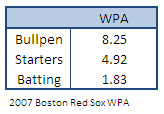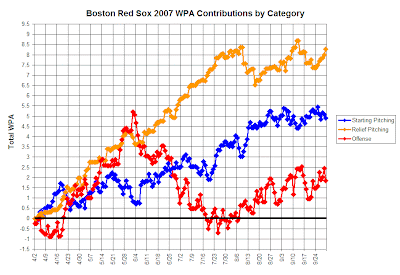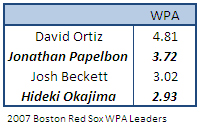For those of you who have followed our walk through the Red Sox lineup while we compared their 2008 prospects to their 2007 performance, we’re at it again with the final installment before our great summation in Friday’s column.
For those of you new to “For Better or Worse”, who haven’t hung on my every word thus far, feel free to get caught up here:
- Installment 1: The Infield
- Installment 2: The Rest of the Position Players and Bench
- Installment 3: The Starting Rotation
To close out the player by player analysis, we make a call to the bullpen. Thanks to Evan for getting all of us off to a head start earlier this week with his look at the battle for the last few spots in the bullpen.
To be realistic however, and not to marginalize the tail of the bullpen, the success of the bullpen, the rest of the staff, and in fact the whole team rests squarely in the those called on to finish games. The successes in the 2007 season would not have been possible without the dominating performances of Hideki Okajima and Jonathan Papelbon.
 To give that statement credence, you have to look no further than Win Probability Added (WPA) stats for the 2007 team. As you can see in this chart, the bullpen’s contribution to Win Probability was greater than the starting pitchers and batters combined. The WPA focused blog Sox Watch details this point out further here. If you look at this data trended over time, the weight that the bullpen carried is further exacerbated.
To give that statement credence, you have to look no further than Win Probability Added (WPA) stats for the 2007 team. As you can see in this chart, the bullpen’s contribution to Win Probability was greater than the starting pitchers and batters combined. The WPA focused blog Sox Watch details this point out further here. If you look at this data trended over time, the weight that the bullpen carried is further exacerbated.

Graph from http://soxwatch.blogspot.com
As you can see when the offense started to slow down, it was the bullpen, specifically Okajima and Papelbon that put the team on their backs.
 In fact, looking at the team leaders for WPA throughout the 2007 season, these two both rank in the top four. The question we should all be asking about the bullpen is can we expect that type of consistent domination from Okajima and Papelbon in 2007? It would appear that as they go, so goes this team and without another top notch set up guy coming in through free agency, it will fall on this dynamic duo again to own the end of close games, coming in and locking them down.
In fact, looking at the team leaders for WPA throughout the 2007 season, these two both rank in the top four. The question we should all be asking about the bullpen is can we expect that type of consistent domination from Okajima and Papelbon in 2007? It would appear that as they go, so goes this team and without another top notch set up guy coming in through free agency, it will fall on this dynamic duo again to own the end of close games, coming in and locking them down.
As we explore what to expect from the bullpen as a whole, I think it makes sense to break it out by group instead of by individual player. Of course, Papelbon and Okajima will be groups unto themselves, but from there we’ll look at a bucket of our other set up men and a bucket of the tail of the bullpen.
Jonathan Papelbon was everything you could ask for in a closer last year saving 37 of 40 save opportunities while absolutely overwhelming hitters as evidenced by 84 strike outs in 58 1/3 innings, an ERA of 1.85, and a WHIP of a microscopic 0.77. There really isn’t more that you can say about the job Papelbon has done for this team than has already been said and his contribution to the team is as, if not more, important as anyone else on the roster. But can Papelbon realistically continue this “near perfection”?
My gut: About the same. Yes he can. Papelbon’s first two seasons as the Red Sox closer aren’t a fluke. As long as he remains healthy, which last years’ usage patterns showed that he can there is no reason to believe that he can’t be a dominant closer again. As with any closer, the line between greatness and disappointment is a fine one with as much in his control as out of it. But at the end of the season, I think you can bank on a 90% plus save percentage, a dominant K rate and sub 2.30 ERA and a WHIP around 1.00. Given the difference between a 2.30 ERA and a 1.85 ERA in the small sample size of innings is only a handful of bad pitches, I feel comfortable that even a 2.00 plus ERA can still be a successful season for Papelbon. The projection systems are conservative on Papelbon, but sample size and situation of use makes predicting bullpen arms the most difficult.
Hideki Okajima was the biggest surprise on the roster last season. While Dustin Pedroia may have won the Rookie of the Year award, Okajima was the most valuable rookie on the Red Sox roster. Okajima led the team in appearances last year with 66 and pitched more innings (69) than any other pitcher out of the bullpen. He consistently pitched those innings in highly leveraged innings and succeeded time and time again ending the season with a 2.22 ERA and 0.97 WHIP even after some struggles down the stretch where his arm must have felt more fatigue than he ever felt in Japan.
My gut: Worse. I would love to think that Okajima could be dominant again, but I have no basis outside of one season of excellence and blind faith to believe he can. The projection systems clearly don’t expect the same performance out of Okajima in 2008. The danger here is two-fold. First, what happens in the innings leading up to Papelbon in 2008 if Okajima struggles? Second, who fills in for the key saves needed when Papelbon needs a night off? It wouldn’t surprise me at all if someone from the group below stepped up into that role more in 2008 (Manny Delcarmen) or if one of the new arms Epstein trotted in this season in what feels like an annual ritual like Danny Kolb, Dan Miceli, or David Aardsma stepped in to an important role. Of course, there’s always old standby Mike Timlin as well. At the end of the day, the potential uncertainty of this situation has to be a concern for the Red Sox going into 2008.
Set Up Men: This group will pitch key innings throughout the year, most likely leading up to Okajima or Papelbon in the sixth through eighth innings or spelling the big two when they are coming off consecutive appearances. Between Mike Timlin, Manny Delcarmen, Julian Tavarez (if/when he’s not starting), and Javier Lopez we’ll see a combination of crucial late inning appearances and bridge innings.
My gut: About the same. The bullpen was excellent last year. But after taking out Okajima and Papelbon, collectively the bullpen performed well but not mindblowingly. Outside of Okajima and Papelbon the bullpen stats look like this 15-9, 3 saves in 9 chances, a 3.52 ERA and a 1.34 WHIP with a 1.64 K/BB rate. I think between this group and the group below, it is reasonable to expect numbers in the same ballpark from these guys plus any additions made between now and the trade deadline.
The Tail: The last spot in the bullpen is likely to be a rolling spot of relievers in and out of Pawtucket or on/off the DL including David Aardsma, Craig Breslow, Bryan Corey, Devern Hansack, Craig Hansen, Edgar Martinez, David Pauley, Kyle Snyder, Danny Kolb, and Dan Miceli.
My gut: About the same. The important thing here is less the aggregate performance of those arms but more the depth they represent. In this case, the team comes into the season with more depth than they had backing up the likes of J.C. Romero, Brendan Donnelly and Joel Pineiro.
At the end of the day, as goes Papelbon and Okajima, as goes the bullpen and the Red Sox chances in 2008. So far, the question mark that sits on top of Okajima is the single biggest potential stumbling block for the Red Sox in 2008. I am hard pressed to believe that collectively this bullpen can live up to it’s 2008 dominance across the board as currently constituted.
So there we have it, we’ve walked through every aspect of the 2008 team in comparison to 2007 and have called our gut, “For Better or Worse’s”. On Friday, we’ll step back and look at the holistic picture we have painted and make our sweeping judgments and predictions about what lies ahead for this team in 2008.
On a side note for those of you interested; I’ll be speaking with the hosts of “On the Field with Colin and Durden” over at BlogTalkRadio live tomorrow at 9:55 pm. You can find the link here to listen live or to hit up the archive of the event the following morning.
